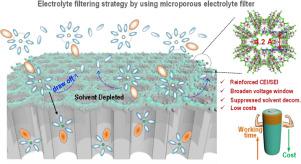Energy Storage Materials ( IF 18.9 ) Pub Date : 2021-09-22 , DOI: 10.1016/j.ensm.2021.09.022 Xingyu Zhu 1, 2 , Zhi Chang 1 , Huijun Yang 1, 2 , Yumin Qian 3 , Ping He 4 , Haoshen Zhou 1, 2, 4

|
The compulsive lithium dendrite growth and inevitable electrolyte decomposition induced by immediate contact between electrodes and free/weakly coordinated solvent molecules within the solvation sheaths of solvated lithium-ions are long-lasting tricky problems that existed in lithium-metal batteries (LMBs). Salt-concentrated strategy can effectively suppress those detrimental issues, the apparently increased production costs, the increased electrolyte viscosities, or even catastrophic battery explosions caused by adding extra salts, however, greatly restrained their successes. Here, by employing a metal-organic framework (MOF) with narrow channel sizes of 4.2 Å (ZIF-71) as a unique electrolyte solvation sheath filter to isolate free or weakly-coordinated solvents from contact with electrodes, we have obtained a special electrolyte composed of merely strongly coordinated solvent molecules. Drawn from the quantitative spectral analysis (FT-IR, Raman), the number of electrolyte solvent molecules in each Li+ solvation sheath was calculated to be 0.54 (the lowest value achieved among carbonate electrolytes), indicated almost completely de-solvation towards the solvated lithium-ions. This ZIF-71 filtered electrolyte displayed remarkably expanded electrochemical stability windows (extended to 5.2 V vs. Li/Li+). When coupled it with two typical high-voltage cathodes (4.4 V-level NCM-811 and 4.9 V-level LNMO), the high-voltage lithium-metal batteries demonstrated remarkably improved electrochemical performances in terms of capacities and lifespans. The cycled high-voltage cathodes and lithium metals demonstrate greatly improved electrode/electrolyte interfaces with negligible cathode electrolyte interface (CEI) and solid electrolyte interface (SEI). This special electrolyte filtering strategy is expected to push the development of high-energy-density LMBs.
中文翻译:

通过用于高压锂金属电池的电解质过滤器筛选溶剂化鞘内的弱配位溶剂
由电极与溶剂化锂离子溶剂化鞘内的自由/弱配位溶剂分子之间的直接接触引起的强制锂枝晶生长和不可避免的电解质分解是锂金属电池 (LMB) 中存在的长期棘手问题。富盐策略可以有效地抑制这些不利问题,但由于添加额外的盐而导致生产成本明显增加、电解液粘度增加甚至是灾难性的电池爆炸,这极大地限制了它们的成功。在这里,通过采用窄通道尺寸为 4.2 Å (ZIF-71) 的金属有机框架 (MOF) 作为独特的电解质溶剂化鞘过滤器,将游离或弱配位的溶剂与电极接触,我们获得了一种仅由强协调溶剂分子组成的特殊电解质。从定量光谱分析(FT-IR,拉曼)得出,每个 Li+ 溶剂化鞘中的电解质溶剂分子数计算为 0.54(碳酸盐电解质中达到的最低值),表明几乎完全去溶剂化为溶剂化锂-离子。这种经过 ZIF-71 过滤的电解液显示出显着扩展的电化学稳定性窗口(扩展到 5.2 V vs. Li/Li+ )。当它与两个典型的高压正极(4.4 V 级 NCM-811 和 4.9 V 级 LNMO)结合时,高压锂金属电池在容量和寿命方面表现出显着改善的电化学性能。循环高压阴极和锂金属表现出大大改善的电极/电解质界面,阴极电解质界面(CEI)和固体电解质界面(SEI)可忽略不计。这种特殊的电解质过滤策略有望推动高能量密度 LMB 的发展。











































 京公网安备 11010802027423号
京公网安备 11010802027423号